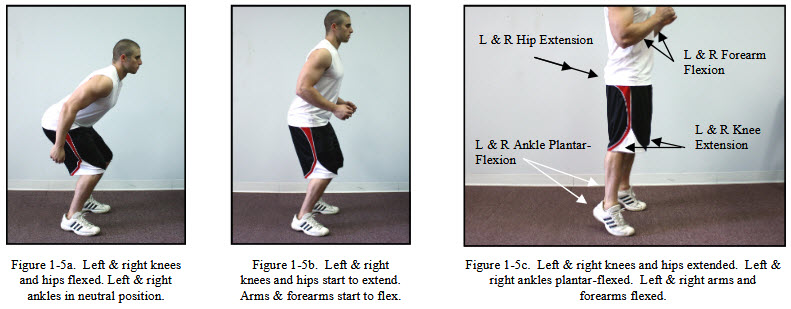Section 1 - Start Here
The Jumping Process
THE JUMPING PROCESS
Jumping in sports, especially basketball, can occur off of one foot as in performing a lay-up or break-away slam dunk, or with both feet as in rebounding. Jumping off of one foot is also common with certain track and field events like the high jump, long jump and triple jump, while jumping off of two feet is common in volleyball where athletes need to jump straight up to block a shot or spike the ball.
The muscles involved in jumping off of one foot when compared to those used in jumping off of both feet are, as one might expect, similar, but there are a few noteworthy differences. Let’s take a closer look at the muscles involved with each.
Jumping off of one foot
Jumping off of one foot typically requires a bit of running or sprinting first to generate the necessary momentum to carry you higher and/or farther. Since most athletes are familiar with performing the lay-up in basketball, which typically involves some running, let’s use that as our model in identifying the muscles involved with jumping off of one foot.
As you may already be aware, right hand players jump off the ground off with their left foot when shooting a lay-up with their right hand and left hand players jump off the ground with their right foot when shooting a lay-up with their left hand. Therefore, and more specifically, we will use the right hand player performing a lay-up as our model in identifying the muscles involved with jumping off of one foot.
Right hand basketball players first run a certain distance and then plant their left foot firmly on the ground before jumping and shooting a lay-up. This is the last contact the left foot makes with the ground before jumping. With the left foot firmly planted on the ground, the left knee and left hip are initially slightly bent or flexed prior to the jump. The right thigh and leg initially trail the left leg a this point. See Figure 1-4a.
As your momentum carries you forward, the trailing right thigh and leg quickly start to flex forward and upward. The left hip and thigh remain slightly flexed. See Figure 1-4b. As the right thigh passes in front of the left thigh, it continues on its path upward to create more momentum. The right arm is flexed upward toward the basket. This occurs at the same time the left hip is extending, the left knee is extending and the left ankle is plantar-flexing. See Figure 1-4c.
Summary: The muscles involved in jumping off of one (left) foot in our example above are: right hip flexors, right knee flexors, left hip extensors, left knee extensors, and left ankle plantar-flexors.
Jumping off of both feet
Jumping off of both feet uses similar muscles, bilaterally, except the hip flexors do not help with your upward momentum and the knee flexors may only recoil the knees slightly after you have left the ground.
The jumping position starts out with both knees and both hips flexed. See Figure 1-5a. As the motion starts, both knees and both hips begin to extend. The arms and forearms also begin to flex. See Figure 1-5b. As the motion continues, both knees and both hips are fully extended and both ankles are plantar-flexed. The arms and forearms continue to flex upward to help create momentum. See Figure 1-5c.
Summary: the muscles involved in jumping off of both feet are: left & right hip extensors, left & right knee extensors, and the left & right ankle plantar-flexors. The left and right arm and forearm flexors are also involved but not illustrated.


